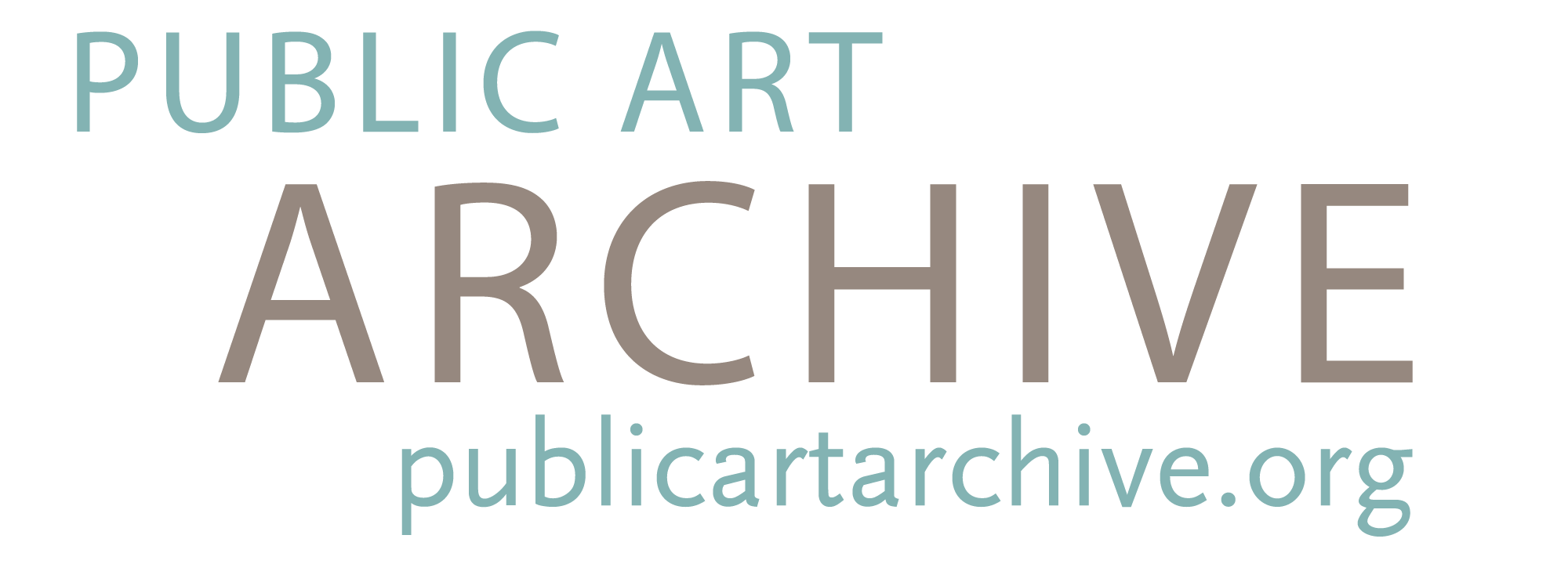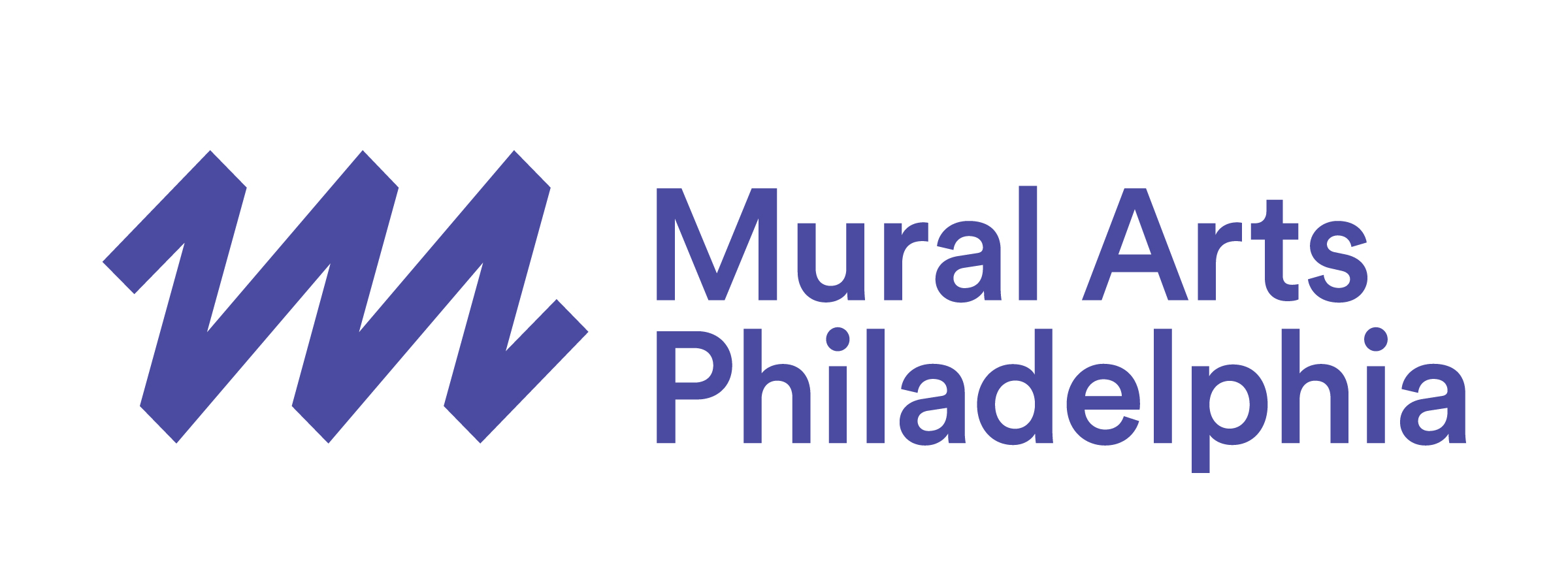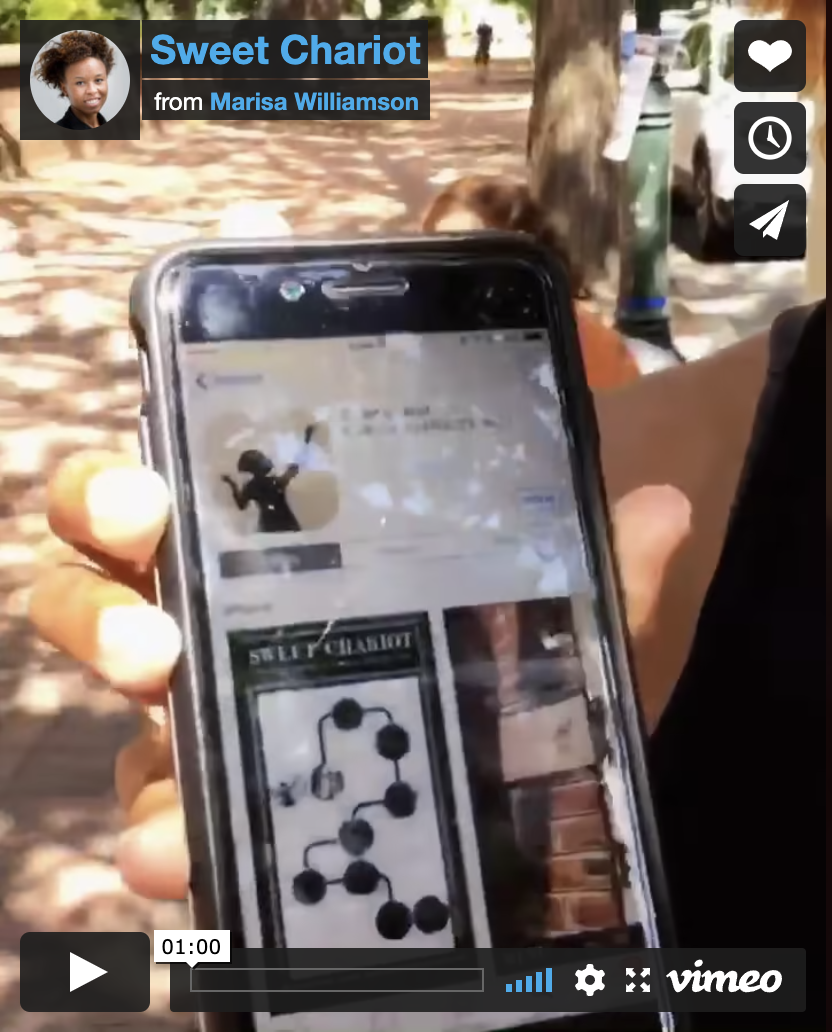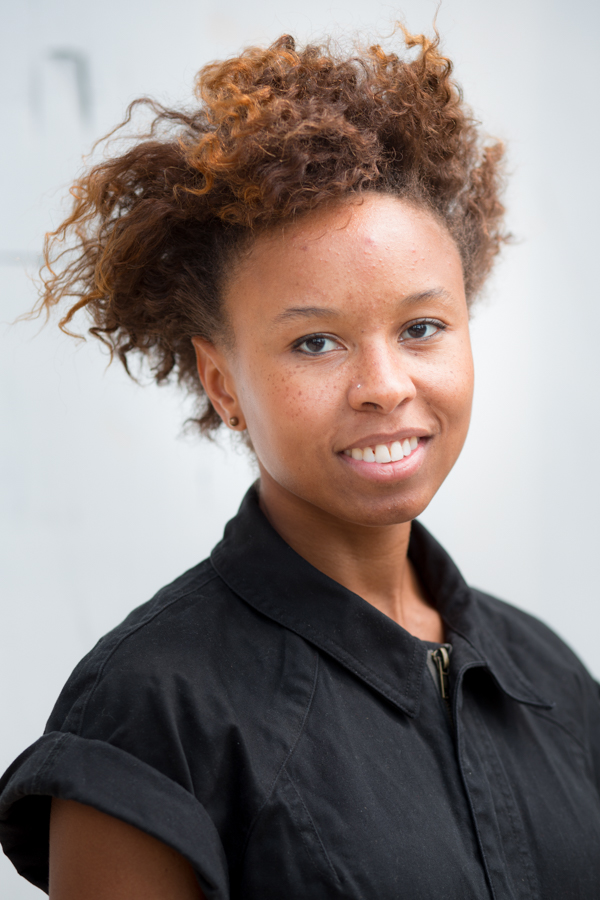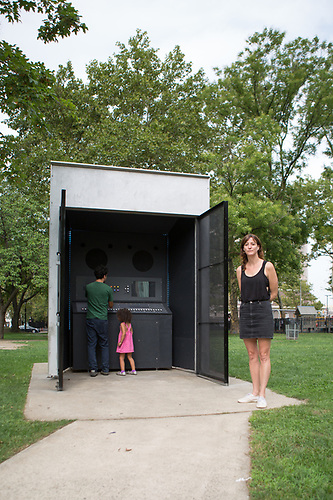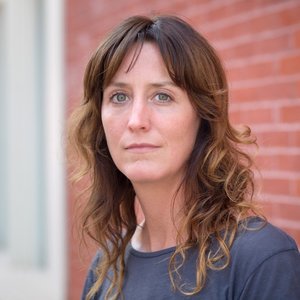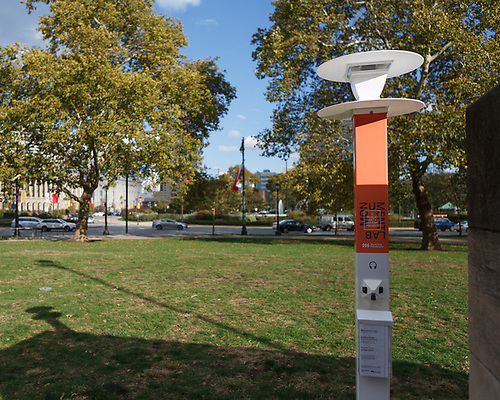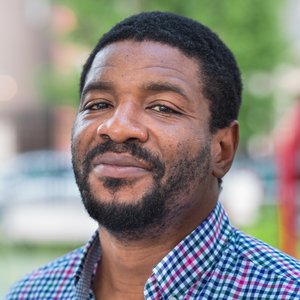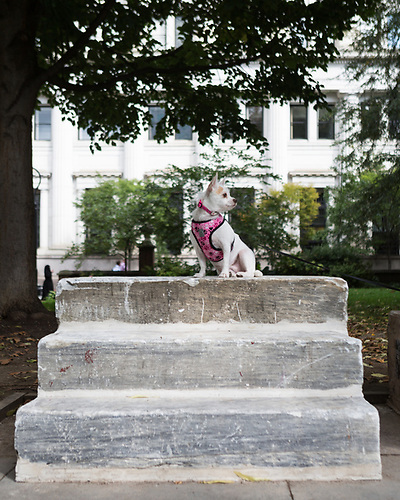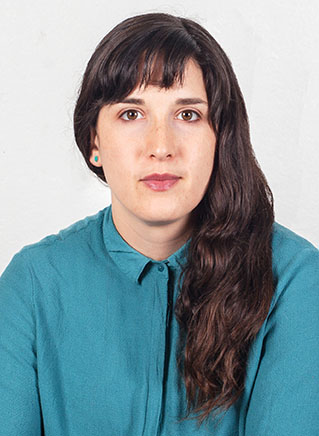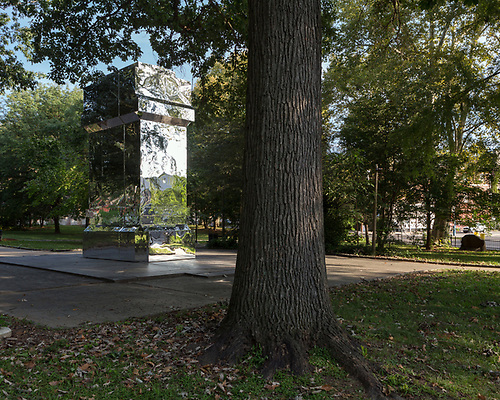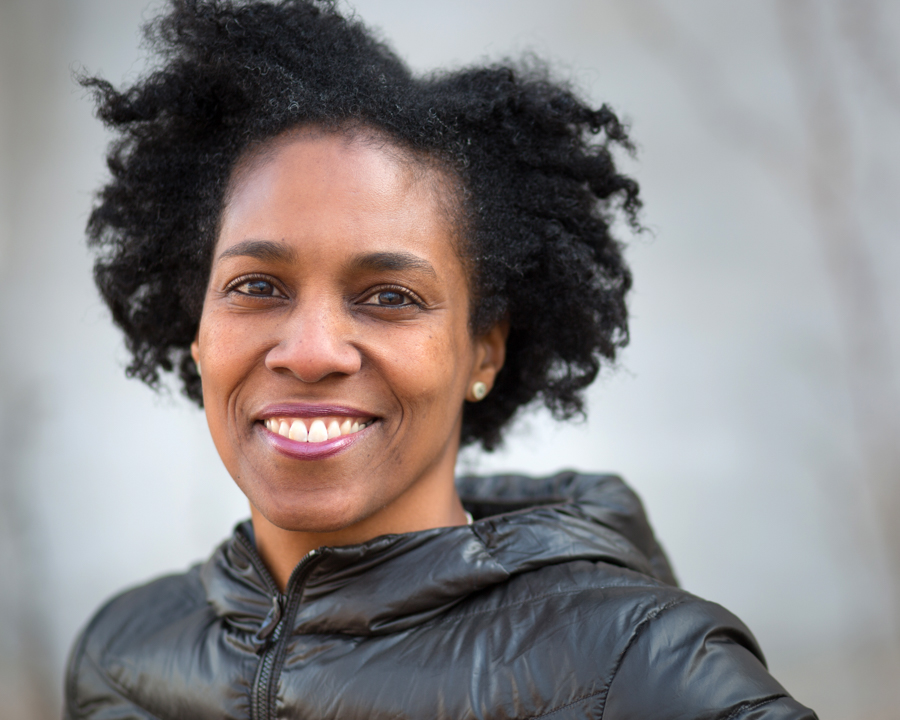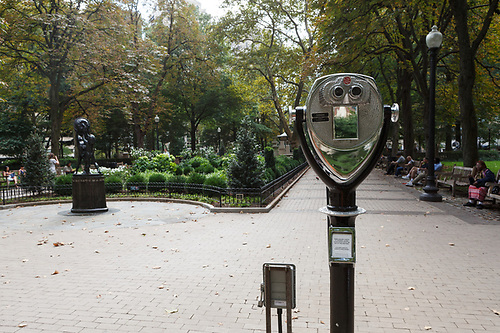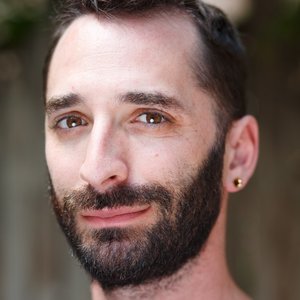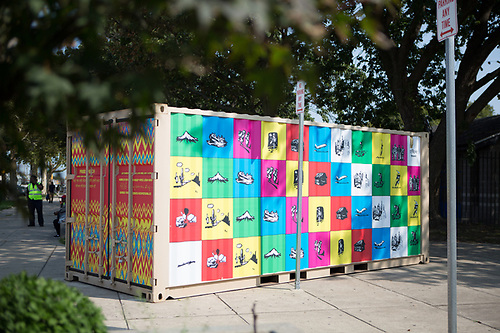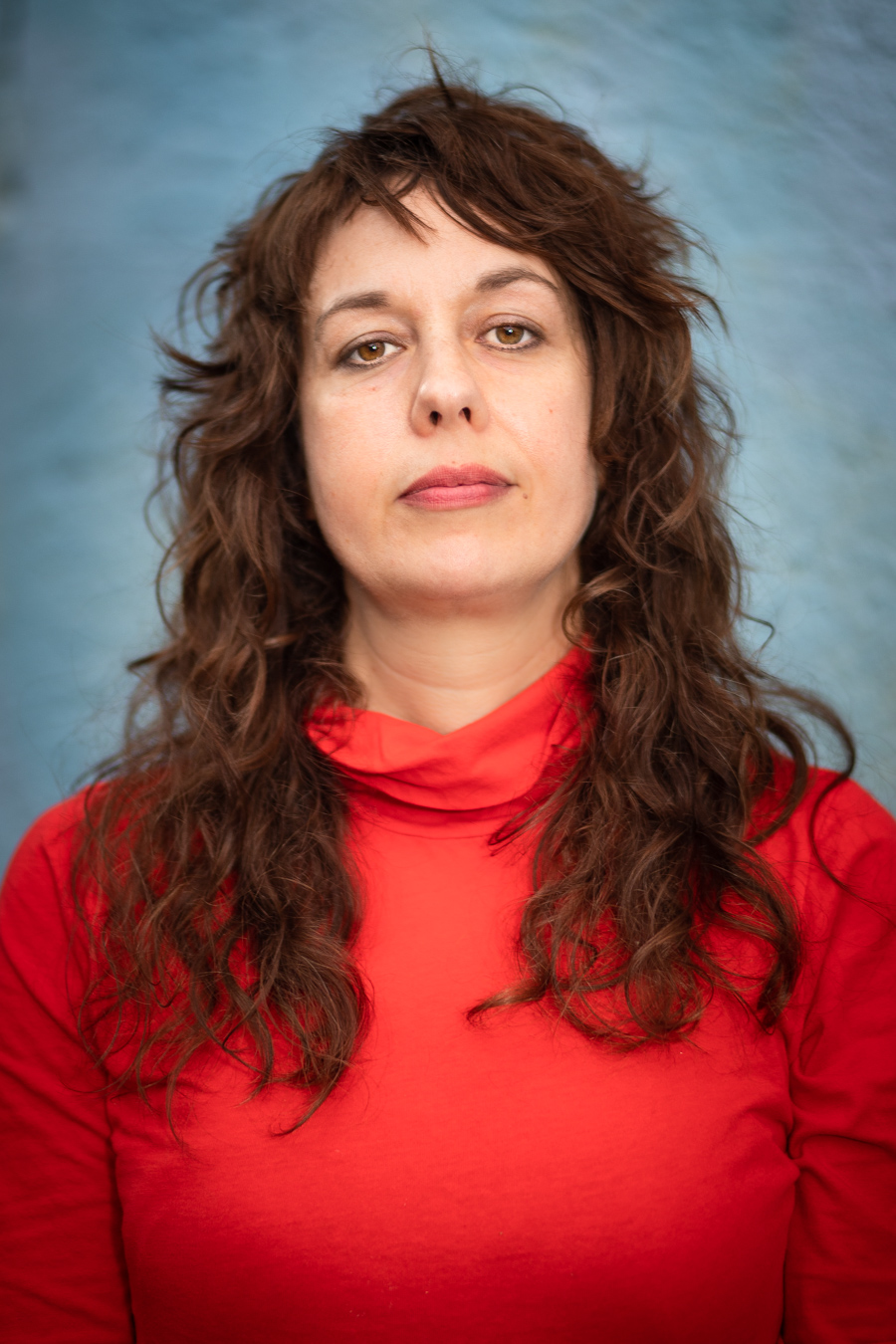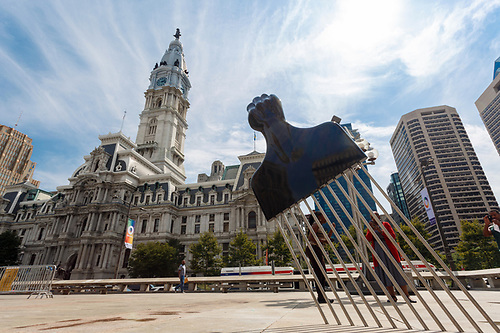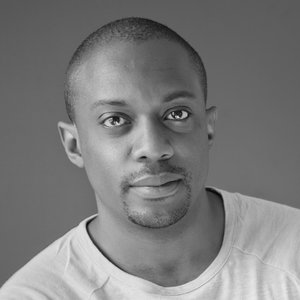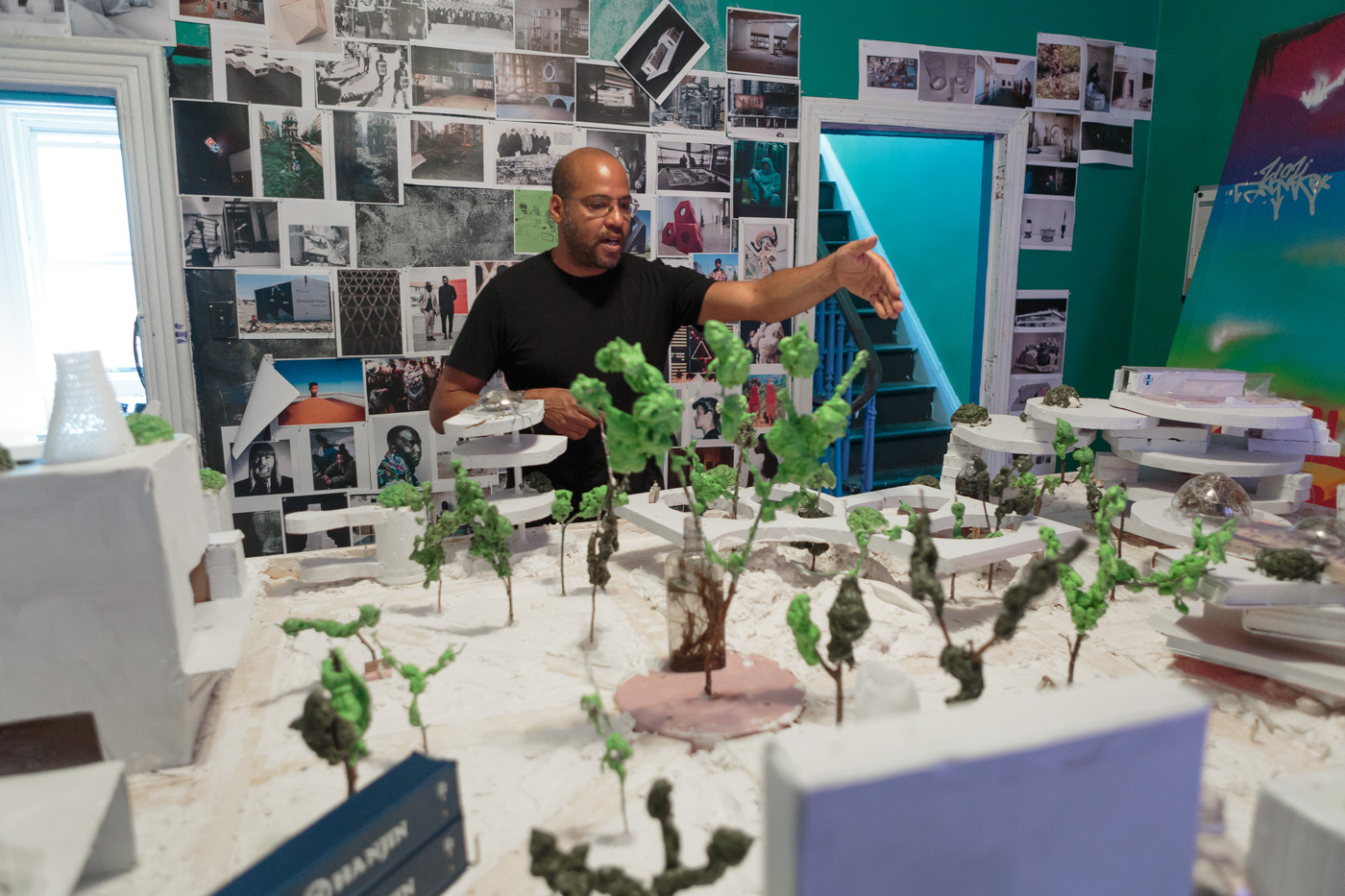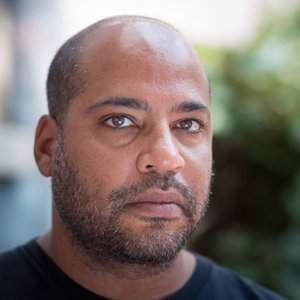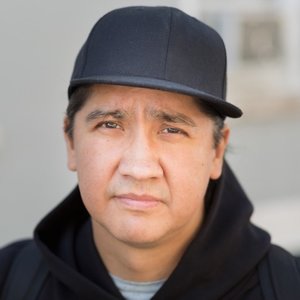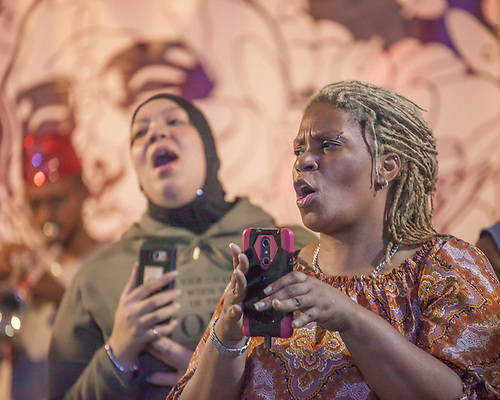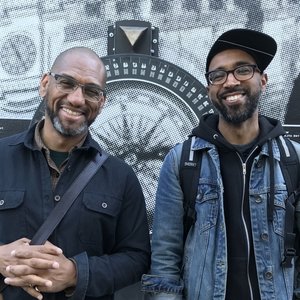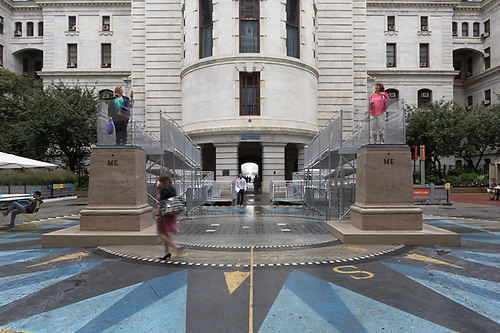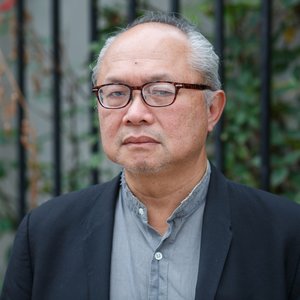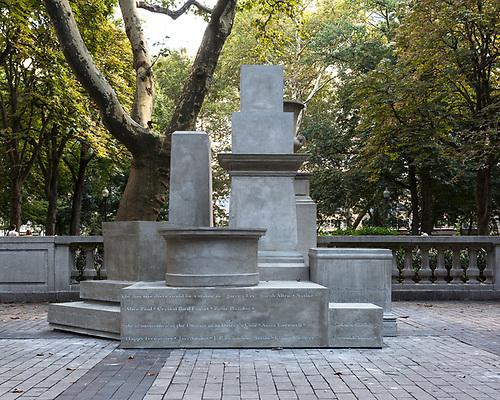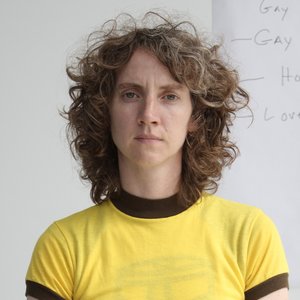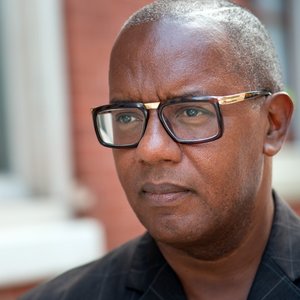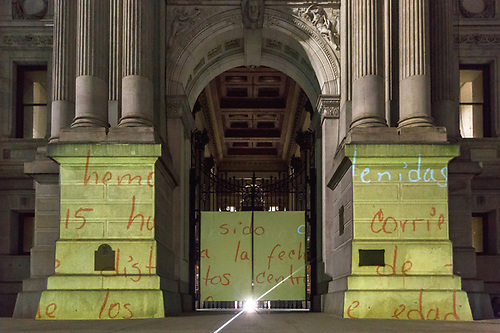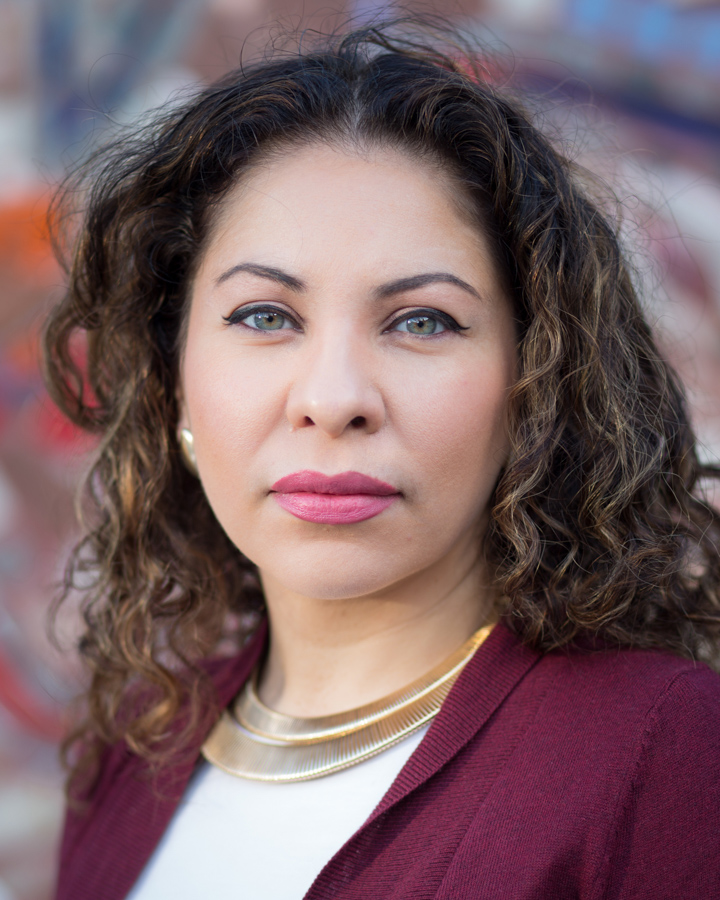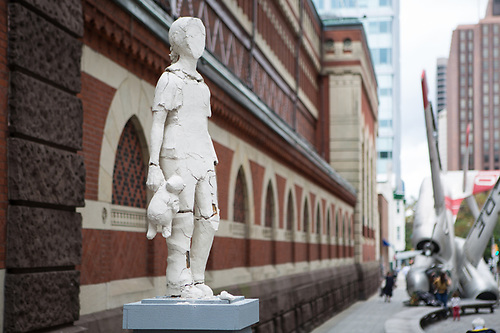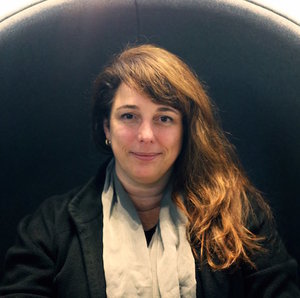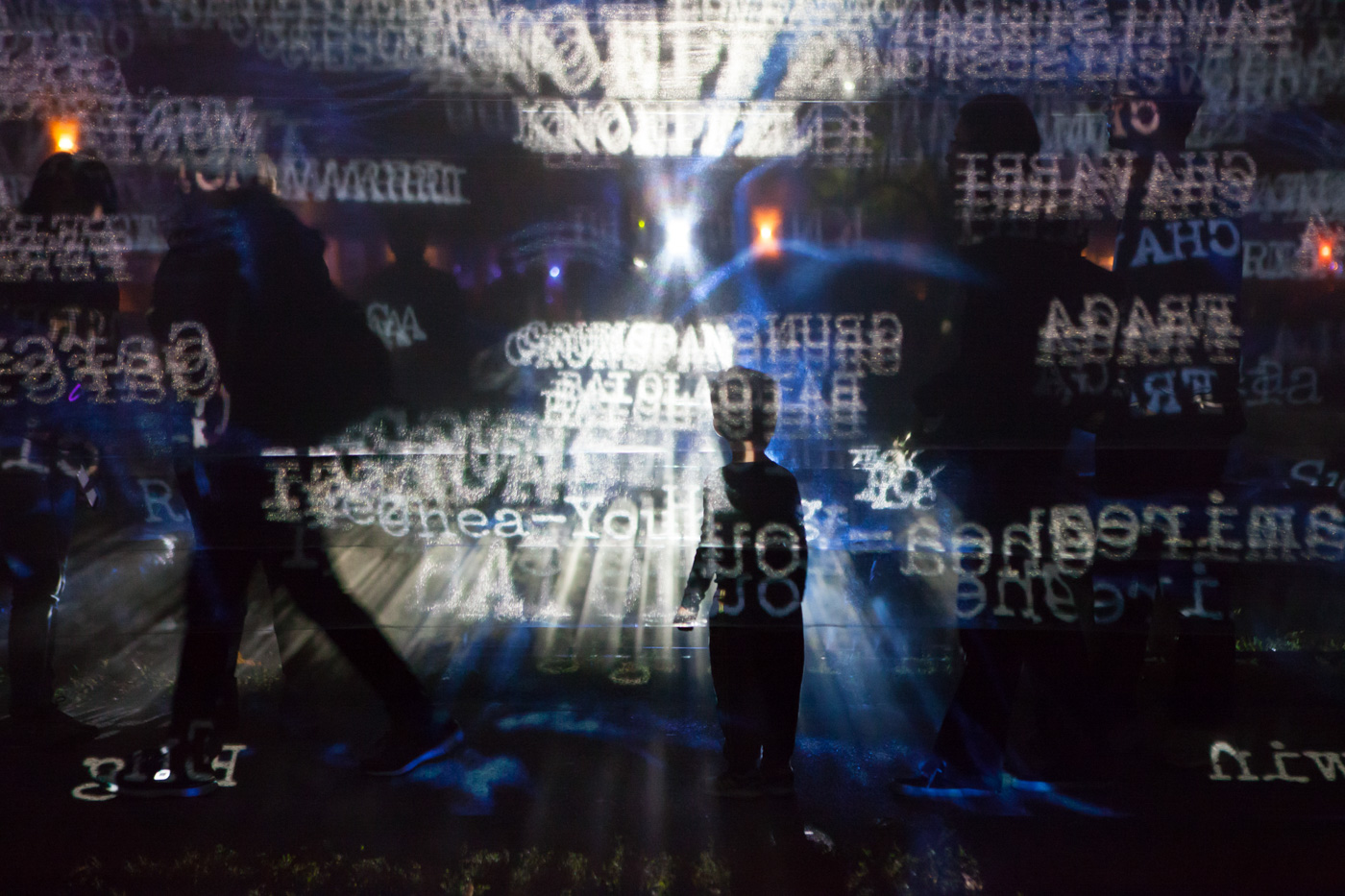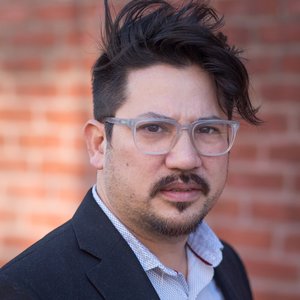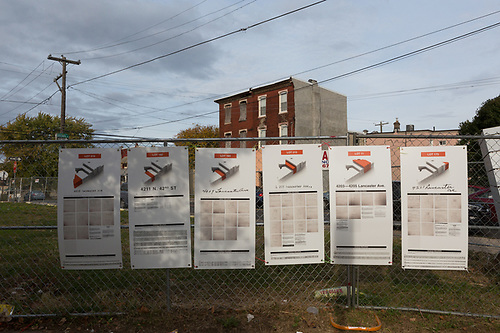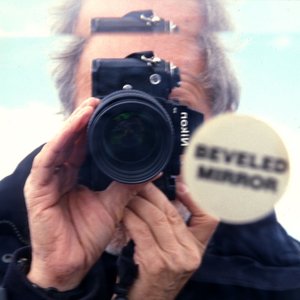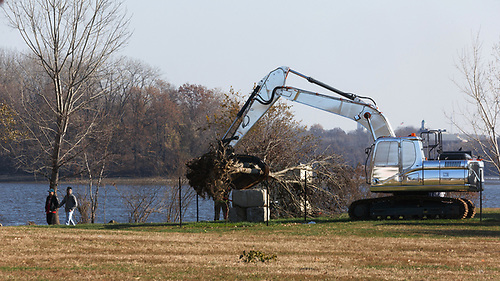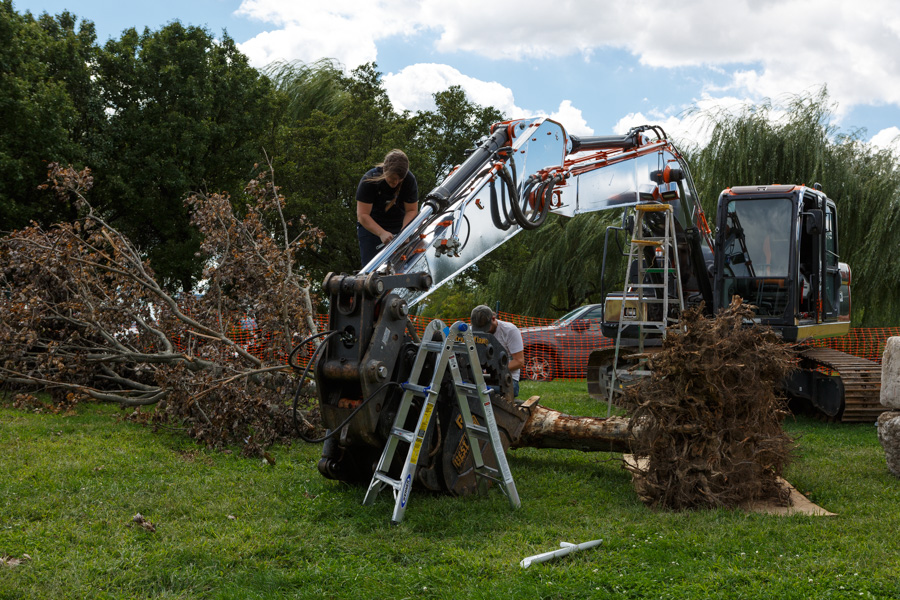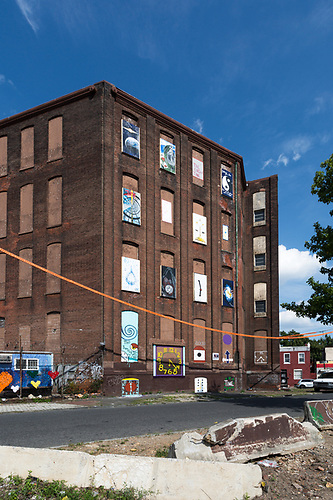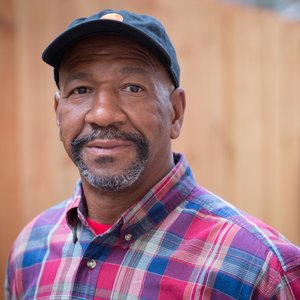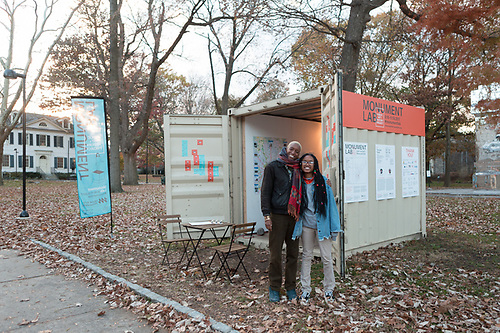Project Dates: September 16 - November 19, 2017
Monument Lab was a public art and history project produced by Mural Arts Philadelphia. The project, taking place over nine weeks between September 16 and November 19, 2017 challenged people to join a citywide conversation about history, memory, and our collective future.
A guiding, central question—What is an appropriate monument for the current city of Philadelphia?—was posed to 20+ of the most dynamic contemporary artists working in Philadelphia and around the world today, selected by curators Paul M. Farber and Ken Lum. Temporary monuments conceived by the artists appeared in public spaces across the city, accompanied by interactive pop-up “laboratories” for creative conversations and research collected by youth art guides. During open hours, staff at all labs distributed information, answered questions, prompted participation, and collected submissions from members of the public.
Mural Arts also created a central hub at the Pennsylvania Academy of the Fine Arts, where all the proposals for Philadelphia monuments of the future, generated around the city during the nine-week project, were scanned and exhibited, culminating in a new museum of ideas and creative data, built by and for the people. And finally, from panels to parties and tours to talks, public programs created ways for the community to participate in Monument Lab—plus, each site hosted its own weekend event, featuring programming created with the artists and neighborhood partners.
Monument Lab projects were located in and around the original squares of the city, as imagined by founder William Penn (City Hall—originally Center Square, Franklin Square, Washington Square, Logan Square, and Rittenhouse Square), as well as five neighborhood parks (Penn Treaty Park, Vernon Park, Norris Square, Malcolm X Park, and Marconi Plaza), three special project sites (PAFA, West Philadelphia, and Kensington), plus the exhibition hub space at the Pennsylvania Academy of the Fine Arts. An additional field research office opened at The Barnes Foundation inside the former Guest Services Center on 20th Street, representing “holistic thinking sitting alongside strategic planning; that moment when audience development and visitor experience come together.” The office was a space for the public to interact with staff and curators, and to submit their own monument proposals. Curators Paul M. Farber and Ken Lum selected a group of intellectually, geographically, and culturally diverse artists from Philadelphia and around the world.
“We are so excited to provide a platform for the 20-plus talented artists who will create artwork throughout Philadelphia for Monument Lab. The range, depth, and breadth of their ideas will have a major impact on the city at a time when it’s more important than ever to have conversations about how we want to be represented in public space.” – JANE GOLDEN
Read more about Monument Lab at the Mural Arts Philadelphia Website
Monument Lab Locations:
Monument Lab YouTube Playlist
Monument Lab Artworks
Marisa Williamson
Sweet Chariot: The Long Journey to Freedom Through Time
On view 9/16/2017-11/19/2017
site-specific work, mobile app, monument
Artist Statement
The “negro spiritual” called “Swing Low, Sweet Chariot” describes a metaphysical vehicle passing low overhead to transport the singer home. Part of the coded language of American spirituality, the song is both warm and haunting; a reminder of the finite nature of life, the long path to freedom, the meandering journey home, and the value of exploration—through the transcendent power of imagination and storytelling.
I set out to make a ghost story. I wanted a story to creep up from behind and blow gently on your neck. And when you turned, I wanted it to flicker off—making you wonder whether you had only imagined it. Sweet Chariot is that ghost story. The guide, Amelia, is borrowed from the past. As with my previous work, I wanted to inhabit a character who could shepherd audiences through doorways, down side streets, in and out of institutions, over centuries, and out of the secret passageways of past, hidden all around us, in plain sight, in the present.
Kara Crombie
Sample Philly
On view 9/16/2017-11/19/2017
kiosk, interactive art, site-specific work, sound installation, monument
Artist Statement
Sample Philly is an interactive and evolving sculpture in Franklin Square that functions as a programmable drum machine and loop station that contains a sound bank of musical samples drawn from Philadelphia’s rich musical history. Participants with all degrees of musical ability and knowledge will be able to create layered songs with sampled audio from Philadelphia’s collective musical culture. I have conceptualized this project with the city’s children, the next generation of artists, specifically in mind. Sample Philly serves as a gateway for children of Philadelphia to become acquainted with the city’s musical history, and its ultimate goal is to provide an outlet for musical creativity in a time when art education has been cut back in Philadelphia and tools of musical expression are inaccessible to many children in the city. Because the monument is interactive, it can also function as a centerpiece for performance events in the city, as well as educational workshops in music production. Our city’s musicians and future artists are also encouraged to contribute to the evolution of the project by submitting samples to the archive so that Sample Philly may be an ongoing documentation of our city’s collective musical expression.
Emekah Ogboh
Logan Squared: Ode to Philly
On view 10/14/2017
site-specific work, performance, sound installation, monument
Artist Statement
I have explored the historic and aural infrastructures of various cities—Lagos, Nigeria in particular—through my sound recordings and installations. These works try to understand cities, mostly through sounds they generate in the form of soundscapes, but also through audio materials found in the city’s archives, and in some cases, through entirely new compositions inspired by the cities.
My proposed work for Monument Lab intends to explore the city of Philadelphia through the concept of collective memory. Herein, I am interested in how Philadelphia remembers (or forgets) its past, and how over time these collective memories have been passed from one generation to the next.
The point of departure for this work begins with what the city of Philadelphia remembers and what it choses not to remember in terms of its history. The question is put across its citizenry in the form of research feedback, either online or offline (website feedback or real-time data collection), and then the resultant feedback is processed.
The idea is to create a musical composition for an orchestral/choir performance from the research feedback. This feedback will either inspire a composer to work with me in creating a new musical composition, or provide us with data that is converted into a musical score. This can be achieved by running the resultant data through an analytical software.
The final composition would be performed by a choir ensemble. I am interested in working with a choir ensemble. The musical piece will be performed by the orchestra/choir and recorded on separate channels for the individual voices and instruments. These recordings will be re-installed as a multi-channel sound installation in a public space.
Kaitlin Pomerantz
On the Threshold (Salvaged Stoops, Philadelphia)
On view 9/16/2017-11/19/2017
installation, site-specific work, stoops, monument
Artist Statement
On the Threshold (Salvaged Stoops, Philadelphia) is a monument to Philadelphia’s distinct neighborhood cultures and varied historic and vernacular architectures, as told through the iconic architectural element of entryway steps, or the stoop. A feature originally associated with Dutch architecture (the Dutch stoep meaning “step”), stoops are prominent on Philadelphia buildings ranging from common row houses to more elite homes. A threshold between private and public space, the stoop functions as a space of social interaction, of relaxation, and of participation. As urban theorist Jane Jacobs described, the stoop is part of an “eyes on the street” community practice, a way for residents to participate, watch, and take care of social spaces.
This monument consists of a dozen stoops that have been salvaged from recently demolished buildings around the city of Philadelphia, and reconstructed using historical and traditional masonry techniques by Bricklayers and Allied Craftsworkers Local 1 PA-DE. These fragments-become-whole-again invite viewers to consider the vast changes taking place in the landscape of Philadelphia—the city’s architectural and social histories, and what is being lost as well as preserved in a time of rampant development. They remind us of how built space shapes social space, and ask us to be active citizens in matters pertaining to the landscape of Philadelphia as it passes into this new threshold of economic growth.
As relics of bygone buildings, the stoops also invite viewers to contemplate the history of Washington Square Park as a site of lives lost and histories buried, as the park once functioned as a common burial ground—or potter’s field—for many years before becoming a public park. These unmarked pieces of material history recall the unmarked lives and stories buried below the soil.
The stoops line Washington Square Park’s easternmost passage, inviting viewers to sit, pass by, engage, and remember. The project will feature a “stoop stories” audio and photo collection, which will be featured in a public archive and with news media partners. Finally, the living vernacular architecture of stoops can be explored in the artist’s Instagram project account, @stoop_phenomena_.
Karyn Olivier
The Battle Is Joined
On view 10/14/2017
site-specific work, installation, monument
Artist Statement
I am covering the Battle of Germantown Memorial with a structure that is constructed using mirrored acrylic. I believe that the physical shrouding of the monument with a reflective surface will allow the sculpture to feel expansive, accessible, and less intimidating than its colossal stature and material weightiness currently permit. The ability to see oneself in the monument would lead us to consider the piece as a living/breathing monument that is not static or staid, but as one that reflects today’s America and our current political and social moment. Monuments are established with the assumption that we as a nation have collectively decided that something should be remembered, honored, and celebrated. In reality, we don’t have equal voices in this mandate, but in my insertion the intention will be for each of us to see and imagine our critical role in the ever-evolving American story. This object will feel undeniably alive—both solid and fluid, self-reflective and outwardly reaching, grand in stature yet utterly humble, reflecting our humanity. I think this “new” monument will be arrestingly beautiful, mysterious and thought-provoking, as the viewer ponders the connection between the park, the object on display, and themselves.
My reinterpretation of the Battle of Germantown Memorial will ask the monument to serve as a conductor of sorts. It will transport, transmit, express, and literally reflect the landscape, people, and activities that surround it. We will be reminded that this memorial can be an instrument and we, too, are instruments—the keepers and protectors of the monument, and in that role, sometimes we become the very monument itself. This marker made of stone is ultimately ephemeral, as are the fleeting sensations and experiences of the park goers. But my goal is for these brief encounters with the monument to be indelibly absorbed. I also hope to disrupt the verticality of the monument through the different axes and orientations the mirrored surface will create. I want the sculpture at moments to feel uncanny, particularly for my Germantown neighbors who’ve most likely walked by this monument countless times, perhaps registering it only marginally after repeat encounters. I hope the familiar (monument) will become strange as a park goer sees the world around, above, and behind her reflected directly before her—allowing or imploring this viewer to acknowledge the present moment and the inherent memory and future it holds.
I will create a metaphoric reflection and link between this monument and the Pastorius Monument that exists a few yards away. I would like to bring to the fore the import of these honorees in the fight for liberty and the tenuous, shifting definition of what it meant to be American. The Pastorius Monument (which was concealed/boxed over during WW I and II because the look of the monument was perceived to be too Germanic, not American enough) was created to celebrate Daniel Francis Pastorius, a German settler (who brought many of the first settlers with him) who led the first Quaker protest and fight against slavery in 1688. Almost 100 years later, the Revolutionary War (which included the Battle of Germantown) was fought to gain America’s independence from Britain. The Battle of Germantown Memorial honored Washington’s “daring campaign to liberate the occupied capital city, Philadelphia” and the “profound impression [it made] upon military critics in Europe.”
Alexander Rosenberg
The Built/Unbuilt Square
On view 9/16/2017-11/19/2017
installation, site-specific work, augmented reality, monument
Artist Statement
Rittenhouse is the only one of William Penn’s proposed squares to stay true to its original purpose, first depicted on a map by Thomas Holme in 1683, a proposed grid of the then-nonexistent city to attract English investors (all the other squares were at some point cemeteries and, in the case of northwest square, public gallows). Looking around the square today, one might wonder how this planned green space ended up containing so many disparate, and in some cases disharmonious, elements. The research attempting to answer this question revealed a great quantity of proposals built and removed, unrealized, temporary and partially completed: an unusual series of structures and events that leave the square with a confusing collection of fragments of mistakes, replacements, and long-forgotten intentions.
My proposed monument acknowledges this site’s constant flux while subtly physically altering the square. What will it look like to see every proposal that has ever been documented for the square? What is it to experience the site today, absent the effects of time?
Viewers will be able to look through and manipulate a pair of binocular viewers mounted on the northeast and southwest entrances to the square, facing inward. They will see a ghostly version of what has, could have been, and never was, all occupying the same space. Other than the viewing devices, a single physical structure will offer a hint to the vast virtual augmentation.
With the aid of augmented reality and modified coin-operated binocular viewers, visitors will be able to see many structures that have been proposed for the site but never built, structures that have been built and removed, and a series of elements that have been altered or moved, all superimposed on the site as we find it today.
Artwork Funders & Partners
- Pew Center for Arts & Heritage (funder)
- Bank of America (funder)
- National Endowment for the Arts (funder)
- City of Philadelphia (partner organization)
- Friends of Rittenhouse Square (partner organization)
- Philadelphia Art Alliance (partner organization)
- City of Philadelphia Department of Parks and Recreation (partner organization)
Shira Walinsky
Free Speech
On view 9/16/2017-11/19/2017
kiosk, interactive art, site-specific work, monument
Artist Statement
A small business is often the first big step many new immigrant and refugee families take in beginning their lives in the US. Free Speech is a metaphor for that first step, a symbol of why so many risk their lives to come to the US. Free Speech is a news kiosk filled with artwork and writing, created over the past six years with Southeast by Southeast—a converted storefront space dedicated to the needs of new refugee families. The newsstand and its materials celebrate refugee and immigrant stories, and feature the artwork of members of the refugee and immigrant communities. Highlighted work includes books made in collaboration with students and teachers, and videos created with students. Collaborations with other artists are in the exhibit and part of an event series.
Hank Willis Thomas
All Power to All People
On view 9/16/2017-11/19/2017
sculpture, art intervention, monument
Artist Statement
This sculpture is an enlarged Afro pick with a power fist cast in aluminum and spray coated in high gloss black with stainless steel teeth. It is approximately eight feet tall and will be supported by a base (not visible above ground) at a slight tilt. The piece should not weigh more than 800 pounds.
The origin of the Afro pick dates back to the time of ancient Egyptians as an article of status and cultural belonging. The clenched black fist comb in particular is associated with the 1970s Black Power Movement. As an accessory of a hairstyle, it represented counterculture and civil rights during one of the most important eras of American history. It exists today as many things to different people; it is worn as adornment, a political emblem, and signature of collective identity. The Afro pick continues to develop itself as a testament to innovation.
This piece serves to highlight ideas related to community, strength, perseverance, comradeship, and resistance to oppression.
David Hartt
For Everyone a Garden VIII
On view 2017
artists’ films, site-specific work, monument
Artist Statement
David Hartt creates work that unpacks the social, cultural, and economic complexities of his various subjects. He explores how historic ideas and ideals persist or transform over time. Born in Montréal in 1967, he lives and works in Philadelphia where he is an Assistant Professor in the Department of Fine Arts at the University of Pennsylvania. He has an MFA from the School of the Art Institute of Chicago and a BFA from the Department of Visual Arts at the University of Ottawa.
His work is in the public collections of The Museum of Modern Art, New York, Whitney Museum of American Art, New York, The Studio Museum in Harlem, New York, The Art Institute of Chicago, Museum of Contemporary Art, Chicago, The Museum of Contemporary Photography, Chicago, Henry Art Gallery, Seattle, The National Gallery of Canada, Ottawa, and The Stedelijk Museum, Amsterdam. David is the recipient of a 2015 Foundation for Contemporary Art Grant; in 2012 he was named a United States Artists Cruz Fellow and in 2011 he received a Louis Comfort Tiffany Foundation Award.
Duane Linklater
In Perpetuity
On view 9/16/2017-11/19/2017
installation, site-specific work, monument
Artist Statement
The birth of Philadelphia as a city was negotiated by two groups of people: the original inhabitants of the area, the Lenni Lenape people—who have lived in the area for thousands of years—and the new settlers from Europe. Upon meeting in what is now known as Penn Treaty Park in Philadelphia, both groups negotiated a treaty to articulate their relationships and responsibilities to each other and to solidify their peaceful co-existence in perpetuity. The actual meeting between Lenni Lenape Chief Tamanend and his counterpart William Penn was not documented in 1683, but is well-situated in the history or Philadelphia—preserved in paintings, monuments, park spaces, remnants of the tree which they sat under, and various writings.
Emerging from this encounter were the words that Chief Tamanend allegedly spoke at the Treaty meeting: “We will live in love with William Penn and his children as long as the creeks and rivers flow, and while the sun, moon, and stars endure.”
A translation of Tamanend’s words, which would have been spoken in the Lenni Lenape language, are now proposed in Penn Treaty Park in near proximity to the Delaware River. These words were given to the artist’s nine-year-old daughter, Sassa Linklater, to rewrite by hand as a kind of family pedagogy, a passing of Indigenous knowledge from one generation to another, a transmission of Tamanend’s poetry from one generation to another. Held up in an aluminum structure housing the illuminated red neon words, in tandem with Bob Haozous’ Indian Land Commemorative (1988), both works articulate Indigenous conceptions of time and duration, the presence of Indigenous people in contemporary Philadelphia and the United States, and the original agreements which still hold so much potential.
Joshua Mays & King Britt
Dreams, Diaspora, and Destiny
On view 10/14/2017
artists’ films, site-specific work, monument
Artist Statement
All of us are here learning who we are through our ancestral make-up and the dreams of what our ancestors wanted for us. They laid the groundwork for our lineage and are now carrying on the dream.
Many of our ancestors were displaced by various circumstances. As we delve into diaspora studies we learn more about ourselves and how we wound up in this present time and space. So what will we do with this, what is the future, and what will we leave?
This project is a two-part youth-driven project that will be a temporary monument to the future in Malcolm X Park.
The forward-thinking and futuristic utopian artwork of Joshua Mays will be the main visual element through the lens of the youth from Mural Arts Philadelphia’s Art Education program.
As part of the multimedia installation, King Britt will provide a sound element as well as a culminating performance on October 14 with local musical legends, creating an improvised work as the audience enters our monumental time portal.
As a tribute to one of our ancestors that laid the groundwork, we will also include some of Malcolm X’s peaceful ideas, to pay respect to the space.
Mel Chin
Two Me
On view 9/16/2017-11/19/2017
sculpture, art intervention, pedestal, monument
Artist Statement
Concepts framed in early Philadelphia loom monumentally in the public mind and express our American identity.
The individual with “inalienable rights” (reinforced by the promotion of rugged individualism in the late 1920s that continues today) is combined with the “We” of “We the People.” These ideas, from two historic documents that define our values as Americans, are brought together as components of a two-part installation, revealing contradictions and activating a curious dialectic.
The current egomaniacal cult of celebrity, the rise of obsessive selfiedom, and the instagrammable evidence of “Me” is doubled and shares time, space, and focus to become “Two Me,” presenting a divided We. So, the idealized form of collective cooperation is circumvented by this dysfunctional “equal representation.”
Two identical plinths are fabricated to the exact height, scale, and shape as the pedestal for the John Wanamaker Citizen statue in Philadelphia that sits on the eastern, outward-facing skirt of City Hall. They sit side by side, but not touching. Instead of “Citizen,” both plinths bear “Me” cast in bronze letters. On the backside of each pedestal is an extensive network of ramps to allow full access to members of the public to ascend and pose as living versions of the bronze citizen. Individuals who step up will complete this monument.
Sharon Hayes
If They Should Ask
On view 9/16/2017-11/19/2017
sculpture, art intervention, pedestal, monument
Artist Statement
If They Should Ask is a temporary monument located in Rittenhouse Square that addresses the absence of monuments to women in the city of Philadelphia. The object is a collection of cast concrete pedestals sourced from existing monuments in Philadelphia and materialized at half-scale. Encircled with the names of women who contributed to civic and public life in Philadelphia from early European contact to the present day, If They Should Ask proposes that the persistent and aggressive exclusion of women from this form of public recognition perpetuates historical misunderstandings and reproduces inequality in the city’s economic, social, political, and cultural spheres.
Although the city of Philadelphia is home to over 1,500 public sculptures, there are only two that celebrate the life of a real, historic woman—Joan of Arc and Mary Dyer, neither of whom were Philadelphia residents. The common understanding that such an exclusion is a consequence of a patriarchal system that did not value women’s contributions to public life tells only part of the story. This perception ignores the way in which monuments were utilized as part of a larger racial and gendered project in which whiteness and maleness are produced as identities of civic and political power. In this sense, material culture did not merely reflect political power but helped constitute it. Indeed, many white women were involved, individually and collectively, in organizing, advocating, fundraising, and commissioning large sculptures. That white women asserted their public power by constructing a material reality that consistently excluded them, and certainly excluded any women of color, is just one of the curious perversities that attend this moment of visual culture.
Additionally, the political, social, and cultural labor done by women often did not move into or onto the historical record as women were not named or were misnamed as a result of intersecting conditions of racism, settler colonialism, homophobia, and transphobia.
In pointing to the vast contributions that women (inclusive of trans women) make and have made to the city of Philadelphia, If They Should Ask proposes both that these contributions be remembered more actively and prominently in the commemorative objects that populate US cities, and also that to do so requires a collective effort of reimagining what a monument can and should be.
Jamel Shabazz
Love is the Message
On view 9/16/2017-11/19/2017
mural, monument
Artist Statement
So much of who I am is a direct result of the music that came out of Philadelphia during the 1970s, under Philadelphia International Records. It was that constant theme of Love Is the Message that really resonated with me and inspired my creative process since first embracing the arts. As a documentary photographer, the camera is the tool that I use to create.
My main objective in working on this project was to make intimate portraits of the residents of Germantown, centering on the historic Vernon Park as a natural backdrop. I created images that recognize and celebrate the cross-generational connection, from servicemen and women who made sacrifices for this country since WWII to the present, to ordinary citizens, both young and old, who call Germantown home. It is my hope that this mural will serve as a beacon of light bridging the gap between generations and inspiring a spirit of love and remembrance; for love is needed in the world today, and love is the message I wish to convey.
Michelle Angela Ortiz
Seguimos Caminando (We Keep Walking)
On view 9/16/2017-11/19/2017
installation, site-specific work, projection, animation, monument
Artist Statement
My moving monument is a tribute to the undocumented mothers detained at Berks Detention Center, a prison outside of Philadelphia for immigrant families. The work will be an animation informed by the collective stories centered on the mothers’ journey, resilience, and fight for freedom. Their animated stories will be projected on the gates of City Hall in Philadelphia. In addition to the animation, the mothers inside will produce paper flowers that will join the flowers created by participants through creative workshops that I will lead at the Barnes Foundation’s Monument Lab Research Field Office. The flowers will be placed in front of the animated piece and will highlight the messages of the mothers detained.
Tania Bruguera
Monument to New Immigrants
On view 9/16/2017-11/19/2017
site-specific work, statue, monument
Artist Statement
The city of Philadelphia played a pivotal role in shaping the future of the United States: it was the place where the Founding Fathers met to sign the Declaration of Independence (1776) and the Constitution (1787), and it served as temporary capital while Washington, DC was being built. Philadelphia was also one of the cities that saw a massive influx of immigrants from Europe and Puerto Rico, and it welcomed many African Americans who were migrating from the rural Southern United States to the Northeast during the Great Migration between 1916 and 1970.
Thinking about the city’s great history of hospitality and the role that it played in shaping democracy in America, the project consists of a sculpture dedicated to newly arrived immigrants. The statue represents a kid as a metaphor for what is experienced once you immigrate: no matter how old a person is, they need to start over.
The idea behind the statue is not to represent a particular community, but all the immigrants; for this reason, they don’t have any specific gender or appearance, and they do not have a “face.” The lack of facial details is a way to emphasize the sense of precarity that immigrants experience: they are not always in one place; part of them is somewhere else, in their home country, and their identity is formed by their experiences in their new place. The kid walks with a bear, which represents their personal memories. In this way, the immigrant could be seen as a hero and they are never identified in a particular historical figure or any particular migration wave or time period.
The sculpture will be clay, and it will be very detailed; however, it will be exposed to rain, wind, and sun in order to deteriorate and slowly disappear. This performative aspect of the sculpture explains the perpetual and endless condition of immigration: when a community is accepted, there is always a new one asking for hospitality. In the same way, when the first sculpture is completely deteriorated, a new one will be placed on the pedestal to start the process again. This is not only a place to celebrate the newly arrived immigrants, but also a call for solidarity between those who are already established and newly arrived immigrants.
Ricardo Rivera (Klip Collective)
Passage :: Migration
On view 10/28/2017
installation, site-specific work, projection, monument
Artist Statement
We are all immigrants.
A city of immigrants.
Waves of people. Taking flight with hopes and fears.
This immersive video installation surrounds the viewer with the surnames of families that came to Philadelphia through the years. The names pass over and around the viewer in waves; projected on translucent planes of fabric and smoke, creating a floating sensation. By entering, the viewer is an active part of the installation, as the projections wash over their body. Like this country, once you enter, you are a part of it.
Hans Haacke
Digging (Archaeology of the Vacant Lot)
On view 9/16/2017-11/19/2017
installation, site-specific work, monument
Artist Statement
The empty triangular lot bounded by Lancaster Avenue, Brown Street, and North 42nd Street in West Philadelphia is to be the site of an archeological excavation.
By cautiously taking off the weed-covered top layer of the lot, the truncated walls of the three-story houses that once existed on the triangle are to be revealed.
The history of each house is to be researched, dating from the original ownership of the land to the present. To be collected are the names, occupations, and sociologically relevant information about the owners of the properties, the circumstances under which they changed ownership (date, price, mortgages, mortgagees, foreclosures), when they became vacant, as well as personal stories and reminiscences by and about the people who lived there. This information, together with an image of each house, is to be posted on or near the site.
City records, newspapers or neighborhood publications, archives of civic and religious organizations and institutions, as well as memories and personal records from still-living members of the local community are to be explored. In this effort, the participation by people from the neighborhood is to be sought and welcomed.
Possibly, during the excavation, discoveries will be made or ideas will be generated that suggest adjustments in the course of action.
At the time of the inauguration of the citywide Monument Lab project, perhaps only a fraction of relevant information on the site will have been collected. It is to be continued throughout the duration of the project, and beyond. It is a work-in-progress.
RAIR (Recycled Artist in Residency)
Plainsight is 20/20
On view 9/16/2017-11/19/2017
installation, site-specific work, monument
Artist Statement
For Monument Lab, the artist team of Lucia Thome and Billy Dufala comprising RAIR (Recycled Artist in Residency) will exhibit a sculpture consisting of two parts: an uprooted tree salvaged from a waste stream and a large excavator wrapped in reflective chrome film. Set along the margin of Penn Treaty Park, the sculpture absorbs the passing activities and surroundings in its reflective surfaces. In effect, it becomes hidden in plain sight.
RAIR sees the two parts of their project as dialectically tethered, with the earth-moving machine representing industry spurred by the economy while the tree signals depletion and displacement. The tree as a part of nature converted to culture can also symbolize growth and prosperity, as well as grassroots histories and community perspectives.
RAIR’s art is centrally concerned with the question of waste and recuperation. Their proposal is a monument to this moment of intense change in Philadelphia due to developmental pressures, demanding an interregnum in terms of a questioning of the assumption that growth is always for the better. They see this work as a microcosm of Philadelphia’s changing green urban landscape.
Tyree Guyton
The Times
On view
mural, mural painting, monument
Artist Statement
In consideration of the question, “What is an appropriate monument for the city of Philadelphia,” we propose broadening that question to ask, what is an appropriate monument for our country and our world? To that question, we offer THE TIMES, a project designed to explore the concept of time in our lives. Now is the time to move towards positive change. Often we hear the familiar clichés: I don’t have enough time, Time is running out, I don’t have time, What time is it? I need more time, Time is on our side, I wish I could go back in time, etc. Through his work, Tyree challenges us to think consciously about what we’re saying:
Throughout my career, I have explored the concept of time from a visual perspective by playing with clocks. Caricature in style, these clocks often have no hands, or the numbers are traveling backwards, or are mixed up, or the clocks have no numbers at all. My goal is to help people explore how time factors into our lives and how it sometimes hinders our ability to progress, or accelerates our anxiety of not being productive at all. Both are centered on the illusion of time, to do and not do. Plato said, Time is the moving image of reality. What this means to me is that everything we do revolves around time and yet…the only time that we ever really have is the very moment we are in. My challenge with this project is to help people to appreciate the present time. A time to act, think, be and do, HERE and NOW. Yesterday lives only in our mind and tomorrow is not promised. I believe that we must make the most of time and the time to do that is NOW.
—Tyree Guyton
We propose transforming the exterior of the factory at Tusculum into a type of clock monument that visually depicts the importance and relevance of the times we are living in (see exhibit “A”). The factory will literally be covered in clocks of all shapes, colors, sizes and styles. At this stage, the project will be designed as a temporary installation with full consideration given to the material used on the surface of the building. For example, clocks made of wood will be designed to fit into the frames of the windows, as well as actual battery-operated timepiece clocks. A weatherproof outdoor decal (designed specifically for concrete) will be used on the actual bricks of the factory.
Some clocks may be shipped from Detroit but most will be created on site. The community will be encouraged to participate by helping to create handmade non-timepieces and by working with Tyree to transform the structure. We will also put out a call for a donation of actual timepieces (battery-operated clocks) and handmade clocks on wood. If feasible, the inside of the structure will serve as a workspace to make and paint the clocks. We also envision using the inside to continue the Monument Lab discussions, and/or a collection of responses to the theme of time during the actual installation. Once the installation is complete, we imagine some type of reception/celebratory event.
Paul Farber & Ken Lum
Monument Lab Research/Mobile Labs
On view 9/16/2017-11/19/2017
site-specific work, installation, kiosk, monument
Artist Statement
Monument Lab projects were located in and around the original squares of the city, as imagined by founder William Penn (City Hall—originally Center Square, Franklin Square, Washington Square, Logan Square, and Rittenhouse Square), as well as five neighborhood parks (Penn Treaty Park, Vernon Park, Norris Square, Malcolm X Park, and Marconi Plaza), three special project sites (PAFA, West Philadelphia, and Kensington), plus the exhibition hub space at the Pennsylvania Academy of the Fine Arts. An additional field research office opened at The Barnes Foundation inside the former Guest Services Center on 20th Street, representing “holistic thinking sitting alongside strategic planning; that moment when audience development and visitor experience come together.” The office was a space for the public to interact with staff and curators, and to submit their own monument proposals. Curators Paul M. Farber and Ken Lum selected a group of intellectually, geographically, and culturally diverse artists from Philadelphia and around the world.
Monument Lab Funders:
Lead Monument Lab Partners
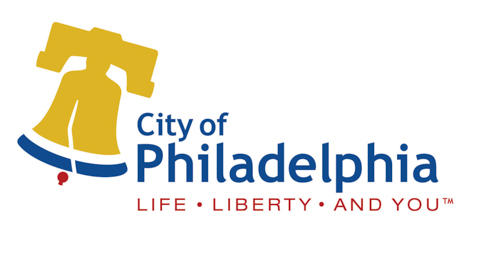

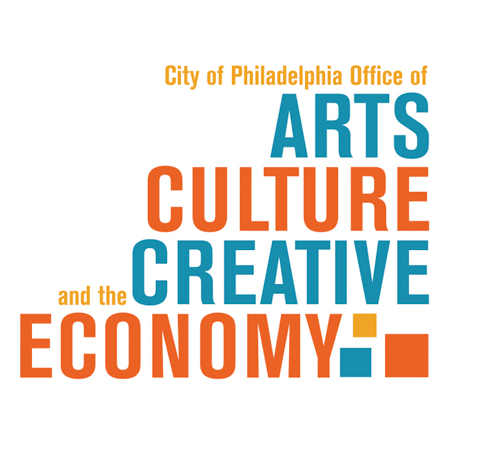

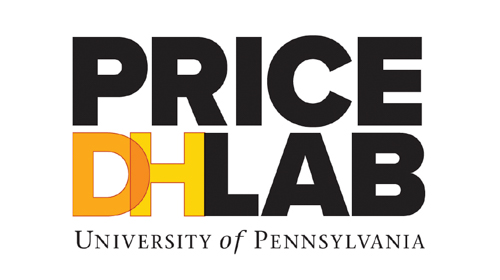
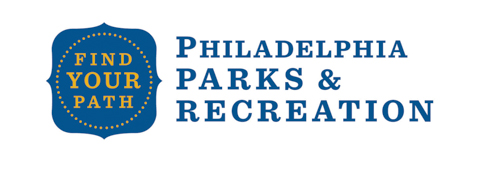
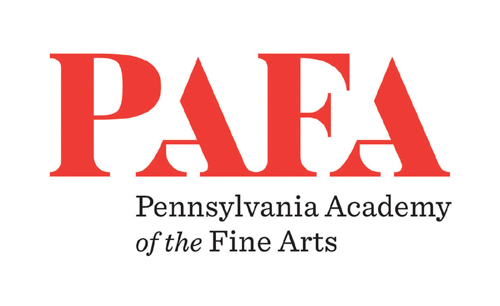
Media Partner
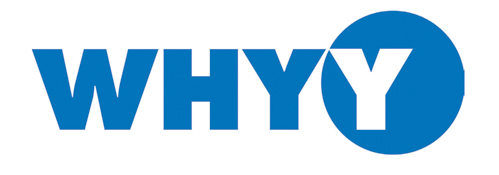
Technology Sponsor

Monument Lab Supporters
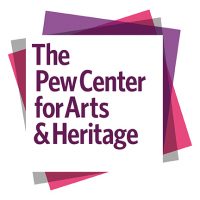
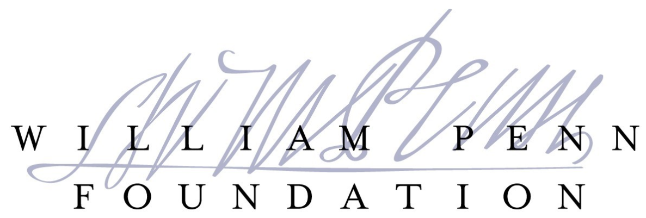
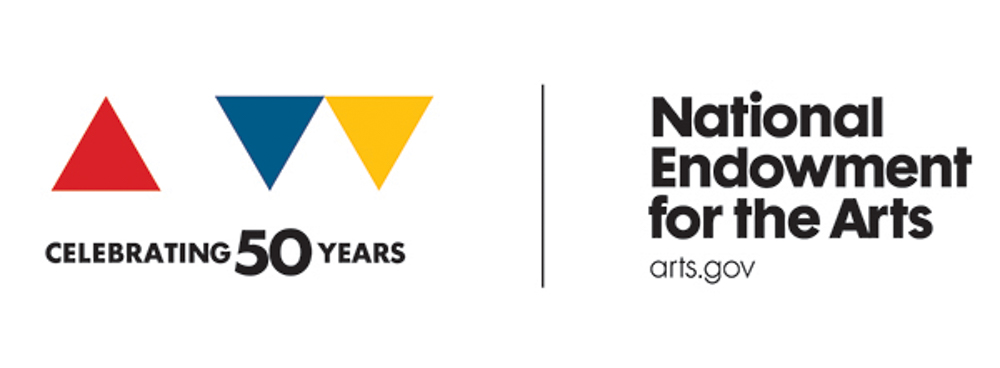
Major support for Monument Lab projects staged in Philadelphia’s five squares provided by The Pew Center for Arts & Heritage. An expanded artist roster and projects at additional neighborhood sites made possible by the William Penn Foundation. Lead corporate support provided by Bank of America. Generous additional support provided by the National Endowment for the Arts.
Luminaries



Innovator
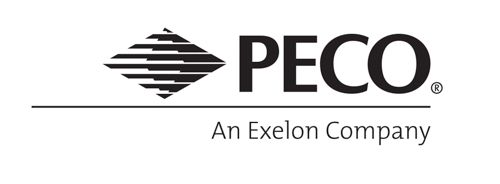
Inventor
Nick & Dee Adams Charitable Fund
Creator
Susanna Lachs & Dean Adler
Patrons
Davis Charitable Foundation
William & Debbie Becker
Parkway Corporation
Joe & Renee Zuritsky
Supporters
Relief Communications LLC
Stacey Spector & Ira Brind
Tiffany Tavarez
KICKSTARTERS
We are grateful to the 432 individuals who supported us on Kickstarter.
Anna Lina Aagenes
Daisy C. Abreu
Karen Adelman
Michael E. Adler, Esq.
Alfie
Kimberly J. Allen
Laurie Allen
An inspired Penn student
Jonathan Anders
Brooke Davis Anderson
Sandra Andino
Daniel & Helena Astolfi
Margaret Bailey
Lisa Bain
Jeffrey Barg
Lynda Barness
Connor & Laura Barwin
Kevin & Joselyn Basden
The Becker Family
Belinda!
Sarah Belkoski
Joe Benford, Deputy Director of Customer Engagement, Free Library Crystal Benner
Amanda Bergson-Shilcock
Dinah Berland
Jon & Carolyn Bjornson
The Black & Morin Families
Leah Blum
Bob, Ketki & Meera
Deb Boyer
Shane Brennan
Todd W. Bressi
Julia Brody & Jim Shaw
Nora Broege
Arielle Brousse
James & Mary Brown
Tracy Buchholz
Rob Burdash
Caitlin Butler & Max Robitzsch Charmaine Butler
Meg Butterworth
Celia C-E
Donna Calderone
Matthew Seamus Callinan
Brian Campbell
Jill Capel
Katherine Carberry
Carbone-Anderson Family
Ennis Carter
Gillian Cassell-Stiga
Catering By Design
Rachel & Jason Cevera
Candy Chang
V. Chapman-Smith & Robert Smith David Charny
Ginny Christensen
Anila Churi
Amanda Clark
Clemence Family
Jay & Joan Cohen
Danielle Cohn & John Young
Mark & Gretchen Cole
Suzanne Cole
Community Design Collaborative John Leonardo Contarino
Emily & David Cooper Moore Susan & Jeremy Coote
Julie Courtney
Will Crowley
James Cuartero
Julie D.
Maire D.
Thomas W. Davis, III
Terryl A. Decker
Catherine del Tito
Cathy Deng
David DeVito
Marisa Diaz
Sara E. Doubleday
Abigail Doucette
Jody Dougherty
Liz Dow
Caroll Drazen
Steven & Susan Dubow
David Dunham
Kevin Dunleavy
Carolyn Edwards
Laura Efros & Noam Kugelmass Logan Elam
Lynn Estomin
Shemise Evans
Natalie Fabe Ubias
Denise & Ed Fagan
Patrice Fanning & Adam McGrath Paul Farber
Diane Faye
Roni Feierstein
Cari Feiler Bender
Alex Feldman
Michele Fenkel
Julia Fiorello
Alex Fogg
Kathleen A. Foster
Jaime Fountaine
Aya Fraser
Martha From
Tracy Gable
Sylvie Gallier Howard
Anne & John Gerbner
Joseph Gianni
Dan Gibbon & Jamie Bischoff
Erin Gillespie
Judie Gilmore
Tamar Godel
David Godfrey
Jane & Joe Goldblum
Jane Golden & Tony Heriza
Bill & Julie Golderer
Marjorie Goldman
Lily Goodspeed
Connor Gray
Michal Greenberg
Steve & Karen Gregory
Erica S. Griffin
Gianna Grossmann
Tyree Guyton & Jenenne Whitfield Greg Hagopian
Jawad Hanna Salah
Cassidy Hartmann
Devin Haselwood
Michael Heaney
Allora Heiberger
Cynthia Heider
Judy Heller & Ed Friedman
Judy Hellman
Allison Henry
Will Herzog
Michael Hoad & Caroline Young William Roy Hodgson
Karyn Hollis
Johnson Hor
Sarah Hromack
Nickie Huang
James Huckenpahler
Thora Jacobson
Monica Jindia
Amy R. Johnston
Mac Joseph
Jo Joye
Jeffrey K. from NJ
Betsy Kalish
Mansura Karim
Kate Karlsen
Kat
Bruce & Joane Katsiff
Leah R. Kauffman
Leslie Kaufman
Holly Keefe
Jenny Kelley
Caroline Estey King
Zachary Klehr
Karren Knowlton
Willa Köerner
Lisa A. Kolker
Brett Krasnov & Diana Montgomery
Susanna Lachs & Dean Adler
Roni Lagin
Chris Landau
Robert Lange
Claire Laver
André Robert Lee
Keith Leistekow
Debbie Lerman
Abby Lesnick
Harris Levy
Jess Lewis-Turner
The Libou Family
Kristin Lindgren
Margelle Liss
Ni’Jhay Logan
Mary Lucking
Ken Lum
Angela M. & Carl C.
Marcia Makadon
Walt Maken
Karl Malkin
Paula & Richard Mandel
Melissa Mandel
Brett T. Mapp
Courtney Marello
Jake Margerum
Thomas F. Marshall, Portrait Photographer Stuart Marshall
Michael Martinez
Anna & Philip Matheson
Jeffrey Matteis
Jane McCaully
Elise McCave
Shayna V. McConville
Megan McFadden & Jenna Skorupa
Amy McGee
Brendan McGeehan
Jim & Erin McHugh
Chris McLeod
Cayla McNally
Katey McTernan
Amanda Melczer
Monica L. Mercado
Alejandro Meza
Trina L. Middleton
Beth F. Millstein
David & Judi Mink
Kathleen Moore Ambrogi
Elizabeth Morgan
Catherine Mouttet
Lisa Murch
Naima Murphy
Armond Netherly
Adamtroy Newson
Janet & Dennis Novack
Samir & Salimah Nurmohamed
Ivy & Matt Olesh
Ninja On-Park
The Oxholm Family
Max Page
Rae Pagliarulo
Scott & Terry Parlee
Pragati Pascale
Penn Treaty Museum
Rachel Pennington
Abby Perkiss
Philadelphia Area Concierge Association Philadelphia School of Circus Arts Ramon L. Picado
Misty Pollen
Nathaniel R. Popkin
Pound for Pound
David & Helen Pudlin
Sylvia Purnell Muldrow
Bryce Quayle
Gaby Raczka
Kristen Raffaele
Daniel Rainer
Pamela Rainey Lawler
Karen Randal
Terry L. Read, Jr.
Joan M. Reilly & Michael DiBerardinis Nick Rimsa
Mariana M. Rodrigues
Marilia Rodrigues
Victoria Rogers
Rory
Eric Rugart
Karen Sabatino
JDR Sales
Dr. Micah Salkind
Maria and Doug Sasso
Erin Scheckenbach
Sara Schwartz
Gary Schwartz
Sea Group Graphics
Barbara Seiple
Naomi Shank & Diomaye Faye
V. Shayne Frederick
Jen Shook
Naas aka Nasi Rushd Siddiqui
Samantha Sieloff & Brian Hathaway
Jonathan B. Singer, Ph.D., LCSW
Sebastianna Skalisky
Skye & Samala
Suzanne Slattery
Jane Slusser
Avery Sohn
Soraya
Damaris E. South
Martha Spanninger & Bob Mueller Stacey Spector & Ira Brind
Abby Stamelman Hocky
Chrissy Starkweather
Nicole Steinberg
Gary P. Steuer
Susan & Andrew Stoessel
Tish Streeten
Wendy Sung
Linda & Ian Swain
Lauren Swartz
Charlotte M. Swenson
Lansie Sylvia
Rachel Tait
Tattooed Mom
Bonnie Thompson
Jacques-Jean Tiziou
Mary Tobkin
Robert Toryak
Kathryn Trabert
Alison C. Traweek
Beth Viner
Amy Virus
Caitlin Vivian
Megan Voeller
Penny Von Eschen
Maureen Wade
Kaylah Walton, University of Penn Class of 2019
Carol & George Weinbaum
Robin Weisz
Jessica Whitelaw
Dawn Whitfield
Judy Wicks
David Wilkes & Jacqueline Ryan
Howard E.N. & Patricia Wilson
Carmen Winant
Benjamin Winkler
Christine Witkowski & Dan Berkowitz
Evan Wolf Buxbaum
Andrew Zitcer
as of 9/11/17
